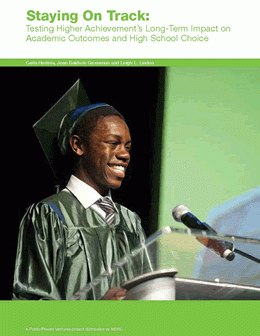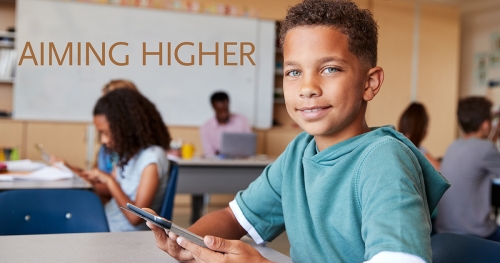Higher Achievement Evaluation

Overview
Under-resourced students will have a steep road ahead as they master new Common Core standards. Schools will also face the challenge of finding sufficient resources to deliver higher-level content in effective, engaging ways. Out-of-school-time (OST) programs, particularly those focused on academic performance, could be one way to provide under-resourced students with the additional support they need. However, there is little information available on how OST services can be used to improve academic skills.
Higher Achievement is a year-round, multi-year program that offers 650 hours annually of standards-aligned academic enrichment to students from fifth through eighth grade. During the school year portion of the program, trained volunteers act as mentors to small groups of students and deliver academic support and instruction, making the cost of the program more affordable. An earlier evaluation found that after two years, Higher Achievement had statistically significant positive impacts on both math and reading test scores.
With support from a U.S. Department of Education Investing in Innovation (i3) grant, Higher Achievement is expanding and implementing a new Common Core-aligned afterschool curriculum. MDRC’s evaluation of this effort will test whether cost-effective out-of-school programs, such as Higher Achievement, can help students meet the new Common Core standards.
Additional Project Details
Agenda, Scope, and Goals
The Higher Achievement Evaluation will examine whether out-of-school programs can help students meet the new Common Core standards by pairing an analysis of Higher Achievement’s impact on academics with an examination of program fidelity, service contrast, and the extent to which mentors’ instruction supports Common Core Common practices, standards, and learning strategies. It will also explore whether Higher Achievement’s new cost-efficient, whole-school model (which serves only children in a middle school feeder system) can achieve the same types of results as its traditional “magnet model.”
In addition to addressing the academic potential of out-of-school programs, the Investing in Innovation (i3) grant will allow Higher Achievement to expand to nine additional centers, strengthen its standards’ alignment, and write new English Language Arts and math curricula for the mentors.
The recruitment for cohort one began in spring 2015, with recruitment for the second cohort beginning the following spring.
Design, Sites, and Data Sources
The Higher Achievement Evaluation will examine impacts with a random assignment evaluation design, using an enrollment lottery to determine whether an applicant enters the program or joins the control group. Students applying to 14 existing Higher Achievement Centers and to five of the nine i3-funded Higher Achievement Centers are invited to participate in the study. Recruitment is taking place over two years from spring 2015 through fall 2016. Each student will be followed for two years by collecting Higher Achievement application information and school records (test scores, grades, and attendance) and by surveying parents. Information about the program’s implementation will come from center director and school principal surveys, mentor baseline and follow-up surveys, and instructional logs filled out by mentors. Data collection will continue through the spring of 2018.
There will be a final report on the project published by December 2019.








